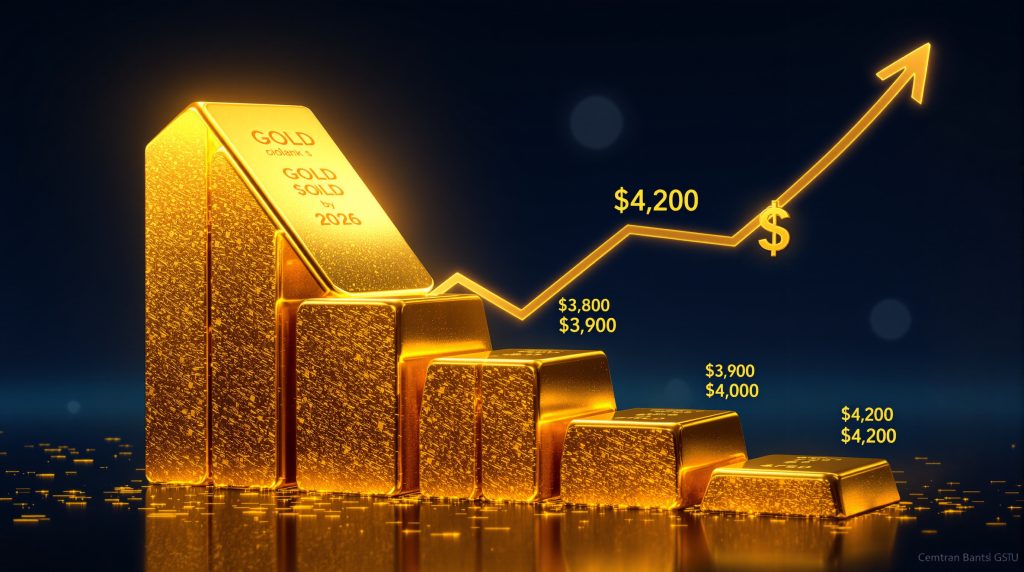How Are Analysts Projecting Gold's Future Price Trajectory?
Gold markets are witnessing a significant shift as UBS has substantially revised its gold price forecast upward, now projecting that the precious metal could reach $4,200 per ounce by mid-2026. This bullish outlook represents a dramatic adjustment from earlier predictions and signals growing institutional confidence in gold's long-term value proposition.
The revised forecast comes amid changing global economic conditions and shifting investor sentiment toward safe-haven assets. UBS analysts have pointed to a confluence of factors creating what they describe as a "bull-case scenario" for gold over the next several years.
Financial data shows gold trading at approximately $3,800 per ounce currently, indicating that UBS expects roughly 10% additional appreciation over the next 18-24 months. This projection stands out as one of the more optimistic views among major financial institutions, highlighting UBS's particularly strong conviction in gold's future performance.
What Factors Are Driving Gold's Bullish Outlook?
Macroeconomic Pressures Supporting Higher Prices
The case for gold's continued rise stems from several interconnected macroeconomic factors:
• Weakening US Dollar: Gold typically shows inverse correlation with dollar strength. Current trends show the greenback losing ground against major currencies, creating a supportive environment for gold prices.
• Central Bank Purchasing: Global central banks continue aggressive gold acquisition programs as they diversify reserves away from fiat currencies. This institutional buying provides substantial support for gold prices.
• Rising ETF Investments: After a period of outflows, gold-backed exchange-traded funds are experiencing renewed interest from investors seeking portfolio protection.
• Inflation Hedging: Despite central bank efforts to control inflation, persistent concerns about long-term purchasing power erosion continue driving investors toward traditional inflation hedge value.
Portfolio Allocation Recommendations
In a notable shift from previous guidance, UBS is now recommending investors maintain a mid-single-digit portfolio allocation to gold (approximately 5%). This recommendation represents a significant vote of confidence in gold's medium-term prospects from one of the world's largest wealth management firms.
The allocation guidance suggests that even conservative portfolios should maintain meaningful exposure to gold, moving the metal from a tactical position to a strategic component of long-term gold investment strategies.
How Does Gold Function as a Portfolio Stabilizer?
Correlation Benefits in Modern Portfolios
Gold's value as a portfolio component extends beyond potential price appreciation:
• Low correlation with equities: During market downturns, gold often maintains value or appreciates when stocks decline, providing crucial diversification benefits during periods of market stress.
• Limited correlation with bonds: As interest rate environments shift, gold's performance often diverges from fixed-income assets, offering diversification even within the "safe" portion of portfolios.
• Geopolitical risk hedge: In times of international tension, conflict, or uncertainty, gold typically benefits from flight-to-safety capital flows.
• Inflation protection: Unlike paper assets that can be devalued by monetary expansion, gold maintains purchasing power over long time horizons.
These characteristics make gold particularly valuable during periods of market turbulence. The metal's behavior during recent volatility has reinforced its reputation as a stabilizing force in balanced portfolios, especially as traditional stock-bond correlations have sometimes broken down.
What Price Milestones Could Gold Reach Before 2026?
Projected Price Progression Timeline
Based on UBS projections and current market trajectories, gold could reach several key milestones before hitting the $4,200 target:
| Timeframe | Projected Price Range | Key Driving Factors |
|---|---|---|
| Q4 2025 | $3,800-$3,900 | Monetary policy shifts, inflation data |
| Q1 2026 | $3,900-$4,000 | Central bank purchases, ETF inflows |
| Q2 2026 | $4,000-$4,200 | Dollar weakness, geopolitical developments |
This progression suggests that while gold may experience periods of consolidation, the overall trajectory remains upward with significant potential catalysts at each stage. Investors should note that these projections represent UBS's base case and actual performance may vary based on evolving economic conditions.
The path to $4,200 is unlikely to be linear, with technical resistance levels and profit-taking likely creating periodic pullbacks even within the broader uptrend.
How Does the Current Rally Compare to Historical Gold Bull Markets?
Historical Context for Current Price Movement
The present gold market exhibits both similarities and differences compared to previous bull markets:
• 2008-2011 Bull Market: This period saw gold surge from approximately $700 to over $1,900, driven primarily by quantitative easing programs following the global financial crisis. The current rally shares the monetary expansion theme but within a different inflationary context.
• 2019-2020 Rally: During this period, gold climbed from $1,200 to over $2,000, fueled by pandemic uncertainty and unprecedented monetary stimulus. Today's rally builds on that foundation but with more diversified demand factors.
• Current Trajectory: Unlike previous rallies driven predominantly by single catalysts (crisis or stimulus), the current uptrend features multiple support pillars including institutional investment, central bank purchases, inflation concerns, and geopolitical tensions.
This diversification of demand drivers suggests the current rally may have more sustainable foundations than previous bull markets that relied heavily on specific economic conditions or policies.
The broader base of support could potentially result in a more durable uptrend, though likely with different volatility characteristics than previous cycles.
What Risks Could Derail the Bullish Gold Forecast?
Potential Challenges to Price Appreciation
While UBS maintains a bullish outlook, several factors could temporarily or permanently impede gold's rise:
• US Monetary Policy Shifts: Unexpected hawkish policy changes by the Federal Reserve, such as higher-than-anticipated interest rates or accelerated balance sheet reduction, could create headwinds for gold.
• Price Volatility: Even within the broader uptrend, investors should prepare for significant price fluctuations that could test conviction during drawdown periods.
• Technical Resistance Levels: Historical price points may create psychological barriers requiring substantial momentum to overcome, particularly around round numbers like $4,000.
• Reduced Physical Demand: Economic challenges in key gold consumption markets like China and India could impact jewelry and industrial demand, potentially offsetting investment inflows.
Investors should recognize that even the most well-reasoned forecasts face uncertainty. The $4,200 target represents UBS's assessment of the most likely outcome given current information, but the path to that level will likely include both bullish and bearish periods.
How Are Investment Vehicles Responding to Gold's Momentum?
Gold-Backed Investment Products Performance
The renewed optimism for gold is reflected in the performance of investment products offering exposure to the metal:
Gold-backed ETFs have experienced significant inflows after a period of outflows, indicating shifting investor sentiment. This trend reversal represents a key psychological shift in how institutions and retail investors view gold market surge.
Mining equities have also benefited from gold's strength, with many producers seeing substantial share price appreciation as profit margins expand with higher gold prices. The leverage effect of mining stocks often amplifies gold price movements, providing an alternative way to gain exposure to the metal's trajectory.
Futures and options markets show increasing open interest, suggesting growing participation across multiple investor categories. The derivatives market activity indicates broadening interest beyond traditional gold investors.
These investment flows create a potential virtuous cycle, where price appreciation attracts new capital, which further supports prices. However, this dynamic can also reverse quickly if sentiment shifts.
What Are Alternative Analyst Forecasts for Gold?
Comparing Market Perspectives
While UBS has taken a notably bullish stance with its $4,200 projection, perspectives across the financial industry vary:
Some major investment banks project more conservative targets around $3,600-$3,800 by mid-2026, citing concerns about potential monetary tightening or dollar strength.
Other analysts present even more aggressive forecasts, suggesting potential for $4,500+ under certain economic scenarios, particularly those involving persistent inflation or geopolitical escalation.
The consensus view increasingly acknowledges gold's strong fundamental support factors, even among analysts with more moderate price targets.
This diversity of forecasts reflects the complexity of factors influencing gold prices and the different weighting methodologies analysts apply to variables like inflation expectations, interest rate projections, and geopolitical risk premiums.
FAQ: Gold Price Outlook 2025-2026
What is driving UBS's bullish gold price forecast?
UBS cites multiple factors supporting gold's potential rise to $4,200/oz by mid-2026, including a weakening US dollar, strong central bank gold purchases, rising ETF investments, and gold's effectiveness as a hedge against inflation and geopolitical risks.
How much portfolio allocation to gold does UBS recommend?
UBS recommends a mid-single-digit portfolio allocation to gold (approximately 5%), highlighting its value as a strategic asset with low correlation to equities and bonds.
What risks could prevent gold from reaching $4,200/oz?
Key risks include potential shifts in US monetary policy, price volatility, technical resistance levels, and possible reductions in physical demand from major markets like China and India.
How does this forecast compare to previous gold bull markets?
The current rally differs from previous bull markets by featuring more diversified demand factors, including institutional investment, central bank purchases, and structural economic concerns rather than being driven primarily by a single catalyst.
What investment vehicles offer exposure to gold's price movement?
Investors can gain exposure through physical gold, gold-backed ETFs, mining stocks, and futures contracts, with each offering different risk-reward profiles and correlation to the underlying gold highs analysis.
Further Exploration of Gold Market Dynamics
Physical Market Considerations
Beyond financial factors, physical gold market dynamics continue to influence prices. Mining production constraints, recycling volumes, and fabrication demand all play crucial roles in establishing price floors and ceilings.
Global gold mining production has struggled to expand significantly in recent years despite higher prices, with grade decline and resource depletion affecting output levels. This supply constraint provides fundamental support for prices, especially in an environment of increasing demand.
The jewelry market, particularly in China and India, remains significant despite changing consumer preferences. Cultural factors continue to support baseline demand even during periods of price volatility.
Technological Innovation in Gold Markets
Emerging technologies are also reshaping how gold is traded, stored, and utilized. Blockchain-based gold tokens and platforms are creating new ways for investors to gain exposure to the metal with enhanced liquidity and reduced storage concerns.
Advances in verification technology are improving authenticity assurance, potentially expanding the market for physically-backed gold investments by addressing historical concerns about fraud or misrepresentation.
These innovations may broaden gold's appeal to younger investors who are comfortable with digital assets but seek the stability of commodity backing.
Regulatory Landscape Evolution
Regulatory developments regarding gold ownership, taxation, and cross-border movement continue to evolve globally. Changes in reporting requirements, storage regulations, or taxation policies can significantly impact regional demand patterns.
Banking regulations regarding precious metals holdings as part of capital adequacy requirements also influence institutional demand. Basel III implementation has implications for how banks interact with physical gold markets.
As the monetary role of gold continues to evolve, regulatory frameworks will likely adapt in ways that could either constrain or expand access to the metal as an investment.
Understanding these complex physical, technological, and regulatory dimensions provides investors with a more comprehensive view of gold's potential trajectory beyond the headline price targets that dominate financial media coverage.
Ready to Capitalise on the Next Major Gold Discovery?
Discover significant ASX gold stocks before mainstream investors with real-time alerts from Discovery Alert's proprietary Discovery IQ model, which instantly identifies high-potential gold opportunities. Explore why historic discoveries generate substantial returns by visiting Discovery Alert's dedicated discoveries page and position yourself ahead of the market.




